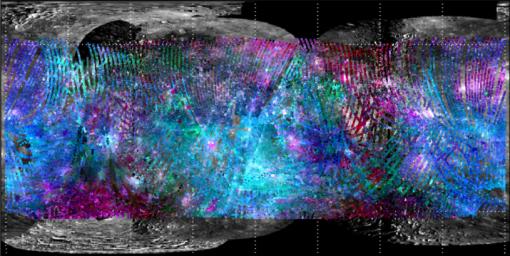
|
Mapping Spectral Variations on Mercury with MASCS
- Click the image above for a larger view
- Full-Res JPEG (1200 x 602) (179.2 kB)
- Full-Res TIFF (1200 x 602) (2.2 MB)
Caption:
The Mercury Atmospheric and Surface Composition Spectrometer (MASCS) collects spectra at ultraviolet to near-infrared wavelengths. Seen here are individual MASCS observations from the first Mercury solar day in orbit mapped over a mosaic of images obtained with MESSENGER's Mercury Dual Imaging System (MDIS). The strongest spectral variations seen by MASCS are at ultraviolet wavelengths. In this color composite, red is 575 nm reflectance, green is the spectral slope (i.e., a measure of the increase in reflectance with increasing wavelength) from the visible to the near-infrared, and blue is a ratio of spectral slopes (the ultraviolet/visible slope over the visible/near-infrared slope). This combination, notably the blue-purple-pink ranges, indicates areas where the ultraviolet variations correlate with geological features.
Background Info:
These images are from MESSENGER, a NASA Discovery mission to conduct the first orbital study of the innermost planet, Mercury. For information regarding the use of images, see the MESSENGER image use policy .
Cataloging Keywords:
| Name | Value | Additional Values |
|---|---|---|
| Target | Mercury | |
| System | ||
| Target Type | Planet | |
| Mission | MESSENGER | |
| Instrument Host | MESSENGER | |
| Host Type | Orbiter | |
| Instrument | Mercury Atmospheric and Surface Composition Spectrometer (MASCS) | |
| Detector | ||
| Extra Keywords | Atmosphere, Color, Infrared, Ultraviolet | |
| Acquisition Date | ||
| Release Date | 2011-10-05 | |
| Date in Caption | ||
| Image Credit | NASA/Johns Hopkins University Applied Physics Laboratory/Carnegie Institution of Washington | |
| Source | photojournal.jpl.nasa.gov/catalog/PIA14866 | |
| Identifier | PIA14866 | |
